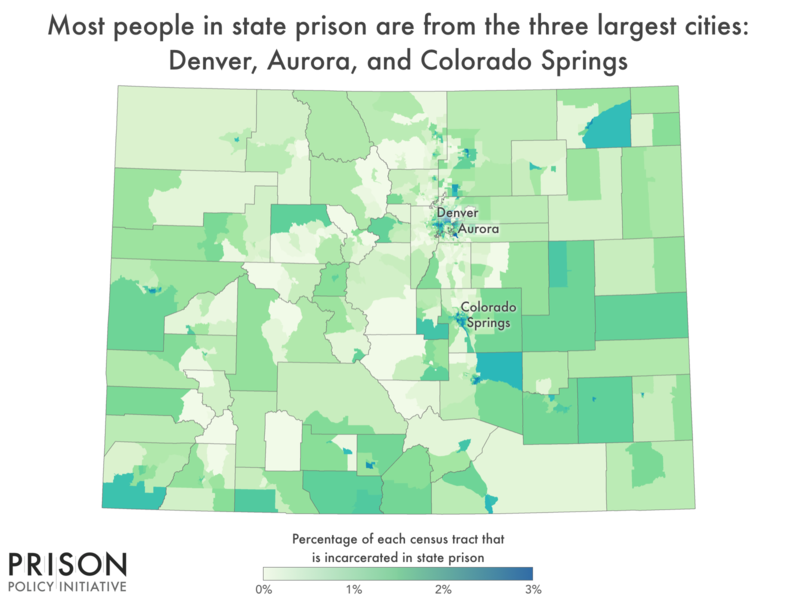New data reveals where people in Colorado prisons come from
Report shows mass incarceration impacts communities in all corners of the state but disproportionately impacts communities of color
July 7, 2022
Today the Colorado Criminal Justice Reform Coalition and the Prison Policy Initiative released a new report, Where people in prison come from: The geography of mass incarceration in Colorado, that provides an in-depth look at where people incarcerated in Colorado state prisons come from. The report also provides eleven detailed data tables — including local data for Denver, Aurora, and El Paso County — that serve as a foundation for advocates, organizers, policymakers, data journalists, academics and others to analyze the impact of mass incarceration on various communities and provide a roadmap where greater investment in community development is needed to improve community wellbeing.
The data and report were made possible by the state’s landmark 2020 law ending prison gerrymandering. It requires state and local governments to count incarcerated people as residents of their home communities rather than their prison locations when drawing legislative districts.
The report shows:
- Every Colorado legislative district — and nearly every county — is impacted where a portion of its population is incarcerated in state prisons, however the degree of that impact varies wildly when you drill down into the neighborhood level.
- Two communities with large Hispanic, Latino, or Native American populations — Alamosa and Bent — have some of the highest imprisonment rates in the state.
- There are dramatic differences in incarceration rates within communities. For example, in Denver, residents of the Elyria-Swansea neighborhood are 20 times more likely to be imprisoned than residents of nearby Washington Park West.
Data tables included in the report provide residence information for people in Colorado state prisons at the time of the 2020 Census, offering the clearest look ever at which communities are most impacted by mass incarceration. They break down the number of people in state prison up by county, city, town, zip code, legislative district, census tract and other areas.
The counties with the most people in state prison at the time of the 2020 census are Denver (2,712), El Paso (2,378), and Adams (1,599).
Meanwhile, the data show the counties with the highest state prison incarceration rates are Alamosa (577 per 100,000 residents), Pueblo (472 per 100,000 residents) and Bent (465 per 100,000 residents). For comparison, San Juan and Mineral counties have the lowest prison incarceration rates, with no residents in prison.

“The nation’s 40-year failed experiment with mass incarceration harms each and every one of us. This analysis shows that while some communities are disproportionately impacted by this failed policy, nobody escapes the damage it causes,” said Emily Widra, Senior Research Analyst at the Prison Policy Initiative. “Our report is just the beginning. We’re making this data available so others can further examine how geographic incarceration trends correlate with other problems communities face.”
The report cites studies that show incarceration rates correlate with a variety of negative outcomes, including higher rates of asthma, depression, lower standardized test scores, reduced life expectancy and more. The data included in this report gives researchers the tools they need to better understand how these correlations play out in Colorado.
“This seminal report is both appalling and not surprising as over-policing and mass incarceration has targeted low-income communities and communities of color for generations,” said Christie Donner of the Colorado Criminal Justice Reform Coalition. “We aren’t facing a crisis of crime, we are facing a crisis of neglect and lack of investment in communities of color and we hope this report will mobilize impacted residents and their elected officials to embrace community development as a public safety strategy.”
The report is part of a series of reports examining the geography of mass incarceration in America.
Colorado is one of more than a dozen states and 200 local governments that have addressed the practice of “prison gerrymandering,” which gives disproportional political clout to legislative districts in which prisons are located, at the expense of other districts. In total, roughly half the country now lives in a jurisdiction that has taken action to address prison gerrymandering.



